Educational Leadership Report: Curriculum Development and Analysis
VerifiedAdded on 2022/08/13
|7
|1305
|16
Report
AI Summary
This report analyzes key aspects of educational leadership, focusing on curriculum development, implementation, and evaluation. It begins by discussing the need for both subject-centered and student-centered curriculum frameworks, particularly highlighting their relevance at different educational levels. The report then explores the importance of stakeholder involvement, including community members, in curriculum design and the challenges associated with differing opinions and communication barriers. Furthermore, it examines the use of data-informed instruction and how educators can leverage real-time student data to improve teaching practices and outcomes. The report references several articles and research papers to support its arguments, providing a comprehensive overview of curriculum leadership principles and practices.
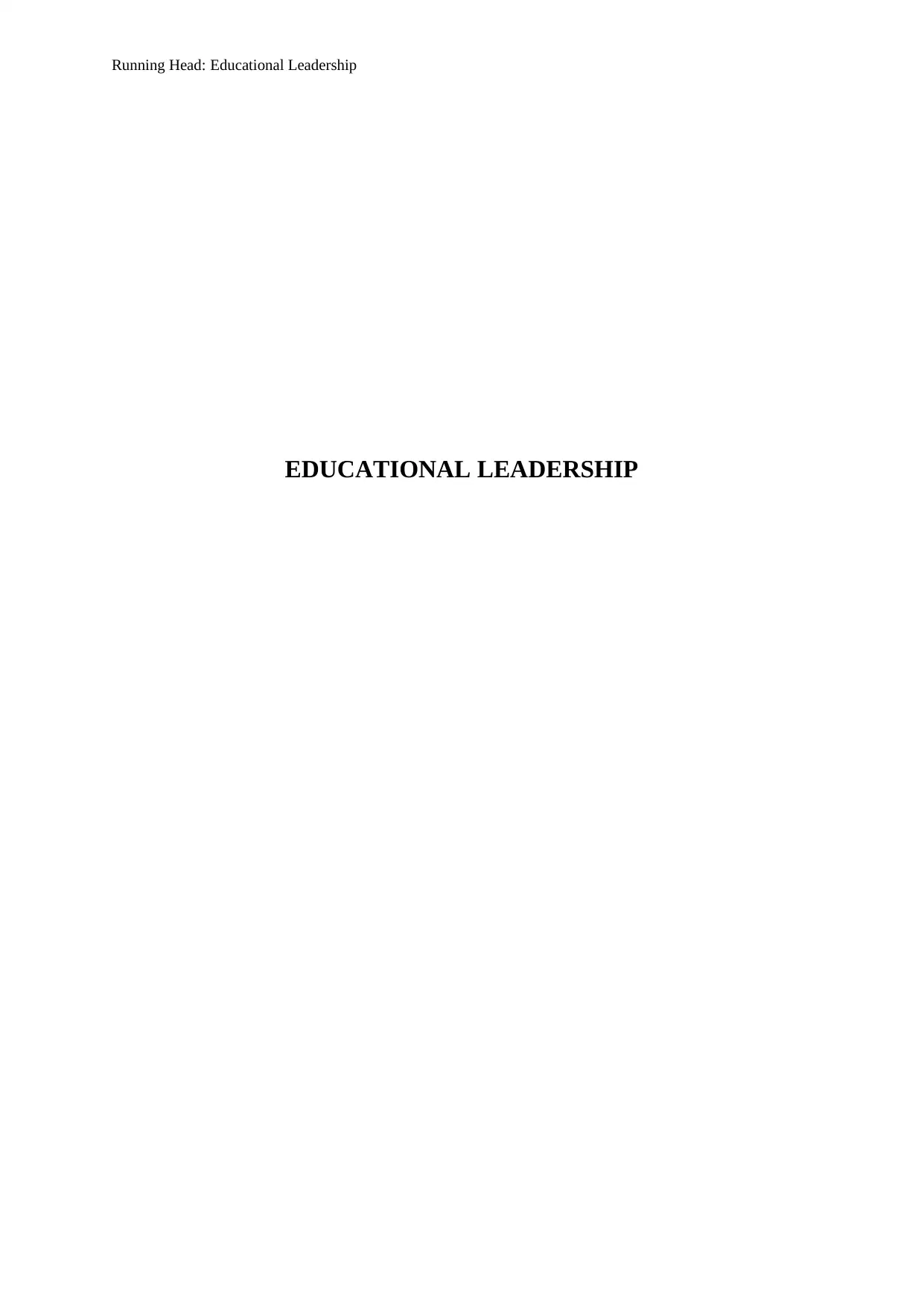
Running Head: Educational Leadership
EDUCATIONAL LEADERSHIP
EDUCATIONAL LEADERSHIP
Paraphrase This Document
Need a fresh take? Get an instant paraphrase of this document with our AI Paraphraser

2
Educational Leadership
Table of Contents
Answer to question 1..................................................................................................................3
Answer to question 2..................................................................................................................3
Answer to question 3..................................................................................................................4
Reference list..............................................................................................................................6
Educational Leadership
Table of Contents
Answer to question 1..................................................................................................................3
Answer to question 2..................................................................................................................3
Answer to question 3..................................................................................................................4
Reference list..............................................................................................................................6
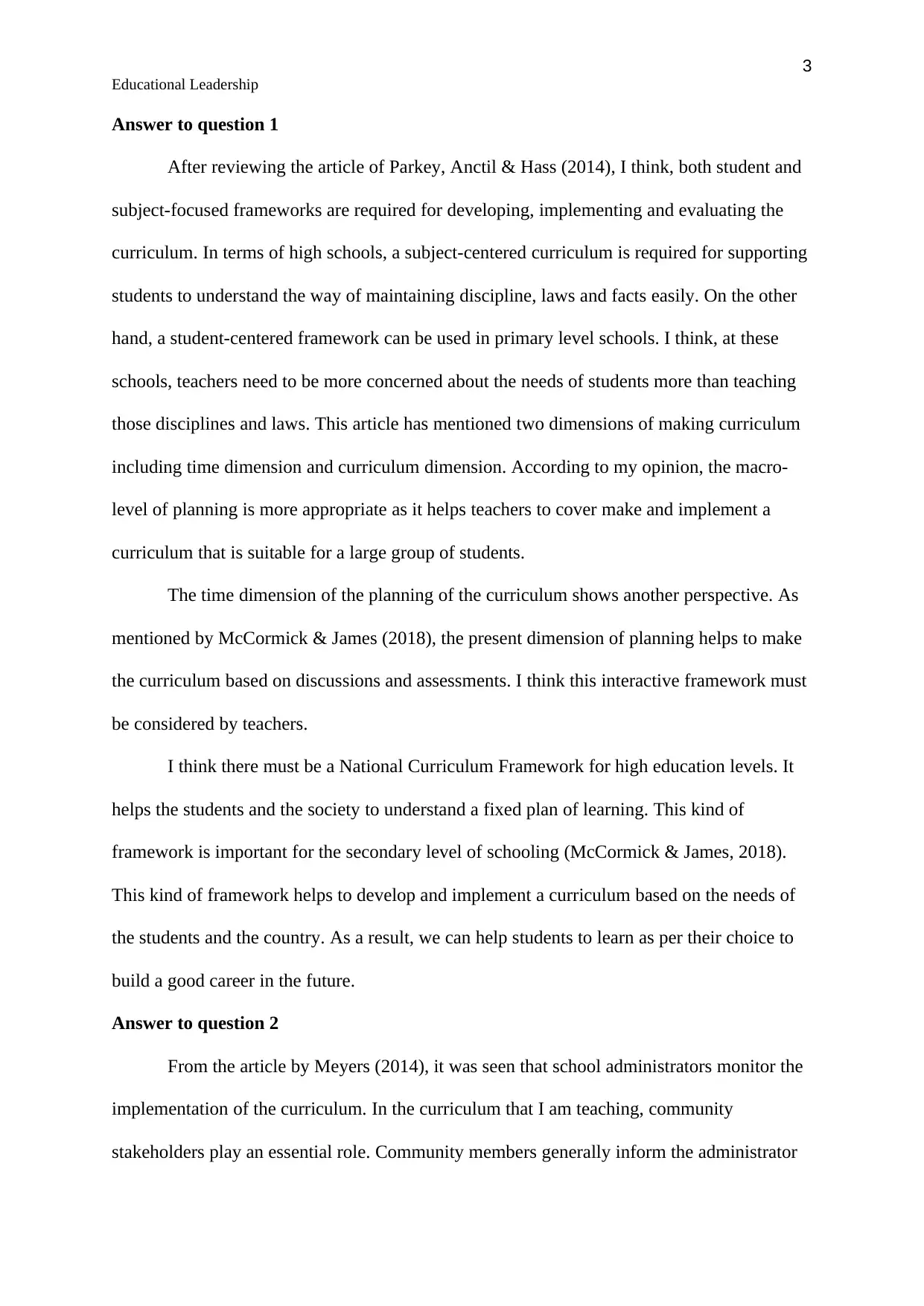
3
Educational Leadership
Answer to question 1
After reviewing the article of Parkey, Anctil & Hass (2014), I think, both student and
subject-focused frameworks are required for developing, implementing and evaluating the
curriculum. In terms of high schools, a subject-centered curriculum is required for supporting
students to understand the way of maintaining discipline, laws and facts easily. On the other
hand, a student-centered framework can be used in primary level schools. I think, at these
schools, teachers need to be more concerned about the needs of students more than teaching
those disciplines and laws. This article has mentioned two dimensions of making curriculum
including time dimension and curriculum dimension. According to my opinion, the macro-
level of planning is more appropriate as it helps teachers to cover make and implement a
curriculum that is suitable for a large group of students.
The time dimension of the planning of the curriculum shows another perspective. As
mentioned by McCormick & James (2018), the present dimension of planning helps to make
the curriculum based on discussions and assessments. I think this interactive framework must
be considered by teachers.
I think there must be a National Curriculum Framework for high education levels. It
helps the students and the society to understand a fixed plan of learning. This kind of
framework is important for the secondary level of schooling (McCormick & James, 2018).
This kind of framework helps to develop and implement a curriculum based on the needs of
the students and the country. As a result, we can help students to learn as per their choice to
build a good career in the future.
Answer to question 2
From the article by Meyers (2014), it was seen that school administrators monitor the
implementation of the curriculum. In the curriculum that I am teaching, community
stakeholders play an essential role. Community members generally inform the administrator
Educational Leadership
Answer to question 1
After reviewing the article of Parkey, Anctil & Hass (2014), I think, both student and
subject-focused frameworks are required for developing, implementing and evaluating the
curriculum. In terms of high schools, a subject-centered curriculum is required for supporting
students to understand the way of maintaining discipline, laws and facts easily. On the other
hand, a student-centered framework can be used in primary level schools. I think, at these
schools, teachers need to be more concerned about the needs of students more than teaching
those disciplines and laws. This article has mentioned two dimensions of making curriculum
including time dimension and curriculum dimension. According to my opinion, the macro-
level of planning is more appropriate as it helps teachers to cover make and implement a
curriculum that is suitable for a large group of students.
The time dimension of the planning of the curriculum shows another perspective. As
mentioned by McCormick & James (2018), the present dimension of planning helps to make
the curriculum based on discussions and assessments. I think this interactive framework must
be considered by teachers.
I think there must be a National Curriculum Framework for high education levels. It
helps the students and the society to understand a fixed plan of learning. This kind of
framework is important for the secondary level of schooling (McCormick & James, 2018).
This kind of framework helps to develop and implement a curriculum based on the needs of
the students and the country. As a result, we can help students to learn as per their choice to
build a good career in the future.
Answer to question 2
From the article by Meyers (2014), it was seen that school administrators monitor the
implementation of the curriculum. In the curriculum that I am teaching, community
stakeholders play an essential role. Community members generally inform the administrator
⊘ This is a preview!⊘
Do you want full access?
Subscribe today to unlock all pages.

Trusted by 1+ million students worldwide
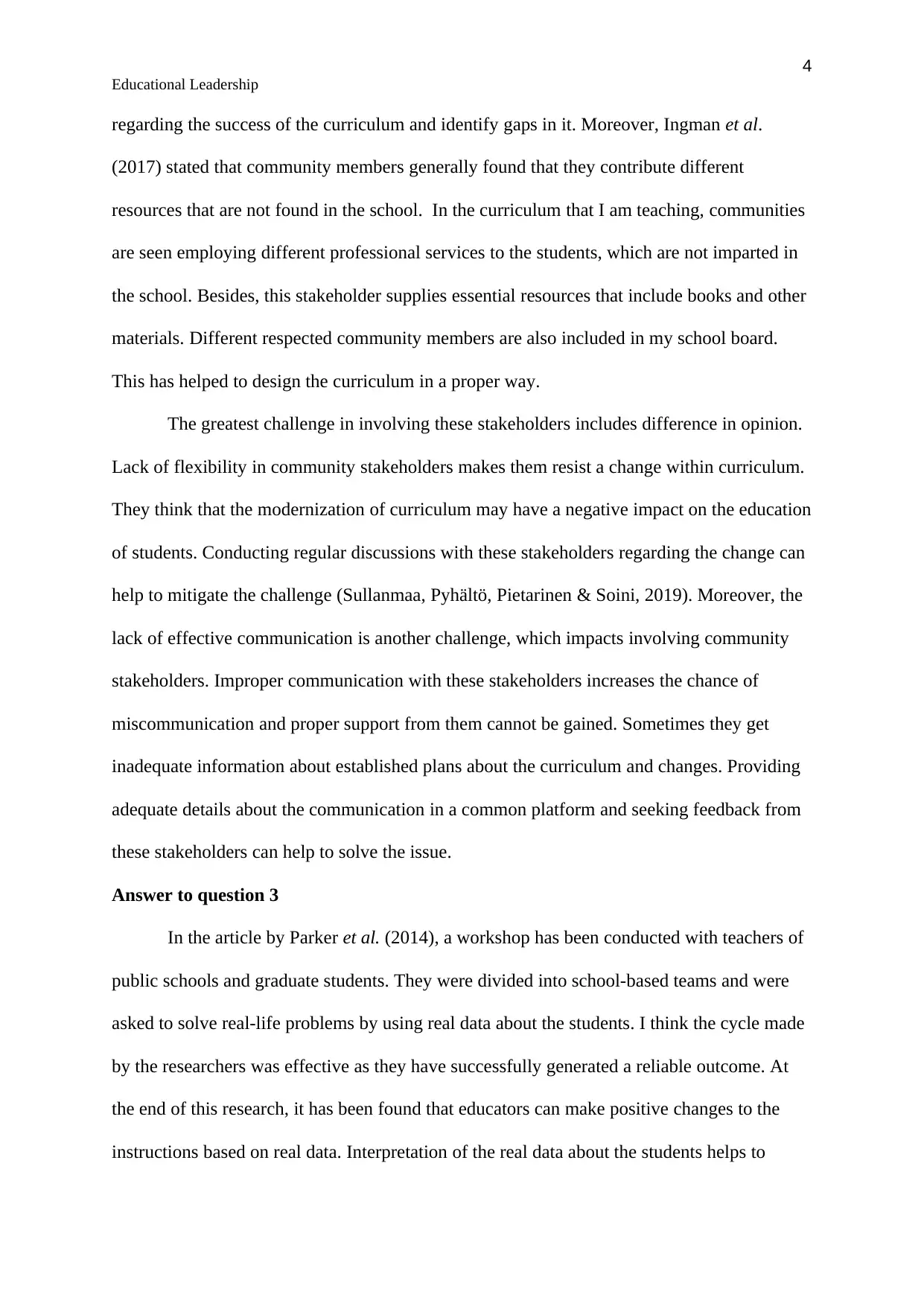
4
Educational Leadership
regarding the success of the curriculum and identify gaps in it. Moreover, Ingman et al.
(2017) stated that community members generally found that they contribute different
resources that are not found in the school. In the curriculum that I am teaching, communities
are seen employing different professional services to the students, which are not imparted in
the school. Besides, this stakeholder supplies essential resources that include books and other
materials. Different respected community members are also included in my school board.
This has helped to design the curriculum in a proper way.
The greatest challenge in involving these stakeholders includes difference in opinion.
Lack of flexibility in community stakeholders makes them resist a change within curriculum.
They think that the modernization of curriculum may have a negative impact on the education
of students. Conducting regular discussions with these stakeholders regarding the change can
help to mitigate the challenge (Sullanmaa, Pyhältö, Pietarinen & Soini, 2019). Moreover, the
lack of effective communication is another challenge, which impacts involving community
stakeholders. Improper communication with these stakeholders increases the chance of
miscommunication and proper support from them cannot be gained. Sometimes they get
inadequate information about established plans about the curriculum and changes. Providing
adequate details about the communication in a common platform and seeking feedback from
these stakeholders can help to solve the issue.
Answer to question 3
In the article by Parker et al. (2014), a workshop has been conducted with teachers of
public schools and graduate students. They were divided into school-based teams and were
asked to solve real-life problems by using real data about the students. I think the cycle made
by the researchers was effective as they have successfully generated a reliable outcome. At
the end of this research, it has been found that educators can make positive changes to the
instructions based on real data. Interpretation of the real data about the students helps to
Educational Leadership
regarding the success of the curriculum and identify gaps in it. Moreover, Ingman et al.
(2017) stated that community members generally found that they contribute different
resources that are not found in the school. In the curriculum that I am teaching, communities
are seen employing different professional services to the students, which are not imparted in
the school. Besides, this stakeholder supplies essential resources that include books and other
materials. Different respected community members are also included in my school board.
This has helped to design the curriculum in a proper way.
The greatest challenge in involving these stakeholders includes difference in opinion.
Lack of flexibility in community stakeholders makes them resist a change within curriculum.
They think that the modernization of curriculum may have a negative impact on the education
of students. Conducting regular discussions with these stakeholders regarding the change can
help to mitigate the challenge (Sullanmaa, Pyhältö, Pietarinen & Soini, 2019). Moreover, the
lack of effective communication is another challenge, which impacts involving community
stakeholders. Improper communication with these stakeholders increases the chance of
miscommunication and proper support from them cannot be gained. Sometimes they get
inadequate information about established plans about the curriculum and changes. Providing
adequate details about the communication in a common platform and seeking feedback from
these stakeholders can help to solve the issue.
Answer to question 3
In the article by Parker et al. (2014), a workshop has been conducted with teachers of
public schools and graduate students. They were divided into school-based teams and were
asked to solve real-life problems by using real data about the students. I think the cycle made
by the researchers was effective as they have successfully generated a reliable outcome. At
the end of this research, it has been found that educators can make positive changes to the
instructions based on real data. Interpretation of the real data about the students helps to
Paraphrase This Document
Need a fresh take? Get an instant paraphrase of this document with our AI Paraphraser
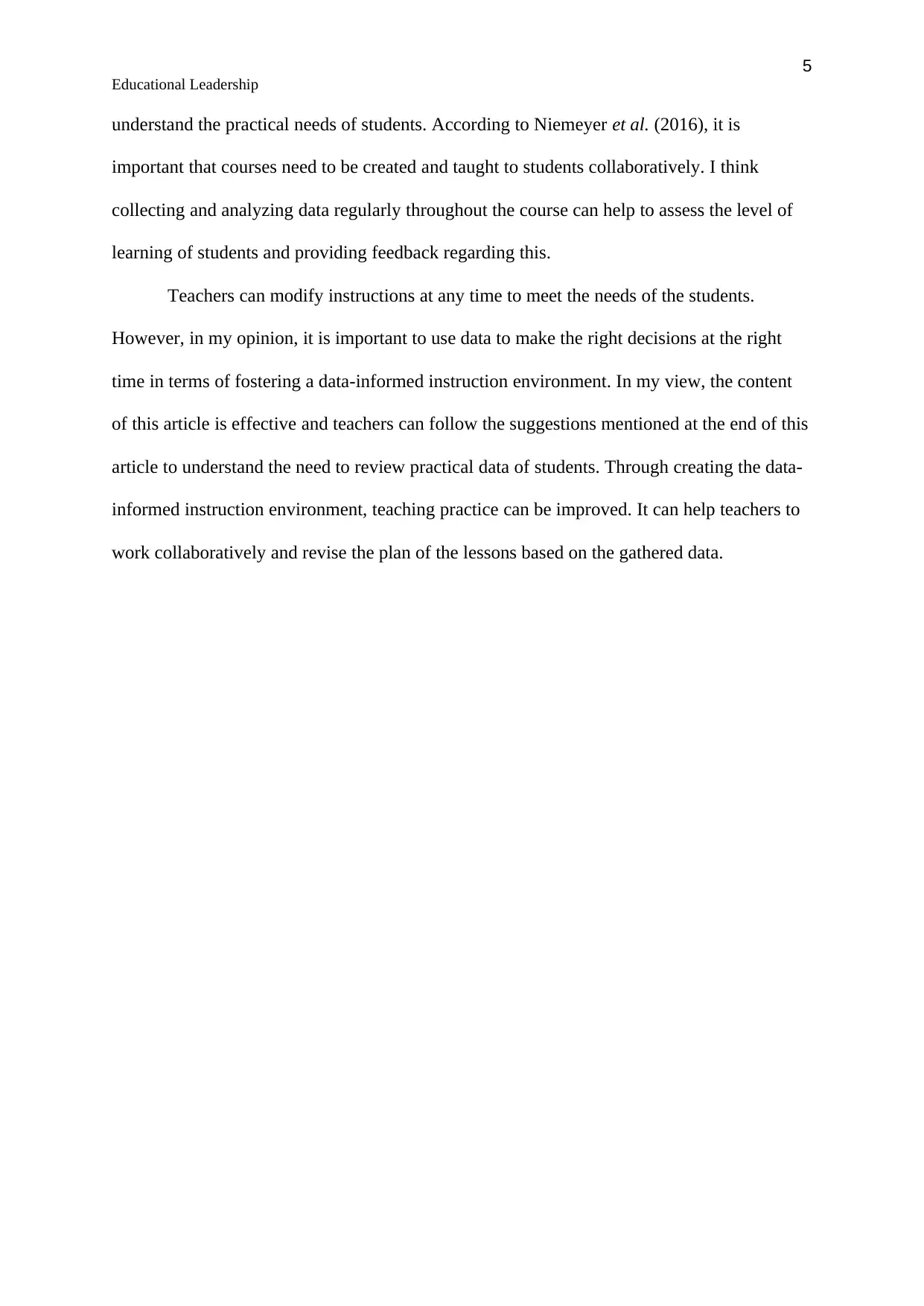
5
Educational Leadership
understand the practical needs of students. According to Niemeyer et al. (2016), it is
important that courses need to be created and taught to students collaboratively. I think
collecting and analyzing data regularly throughout the course can help to assess the level of
learning of students and providing feedback regarding this.
Teachers can modify instructions at any time to meet the needs of the students.
However, in my opinion, it is important to use data to make the right decisions at the right
time in terms of fostering a data-informed instruction environment. In my view, the content
of this article is effective and teachers can follow the suggestions mentioned at the end of this
article to understand the need to review practical data of students. Through creating the data-
informed instruction environment, teaching practice can be improved. It can help teachers to
work collaboratively and revise the plan of the lessons based on the gathered data.
Educational Leadership
understand the practical needs of students. According to Niemeyer et al. (2016), it is
important that courses need to be created and taught to students collaboratively. I think
collecting and analyzing data regularly throughout the course can help to assess the level of
learning of students and providing feedback regarding this.
Teachers can modify instructions at any time to meet the needs of the students.
However, in my opinion, it is important to use data to make the right decisions at the right
time in terms of fostering a data-informed instruction environment. In my view, the content
of this article is effective and teachers can follow the suggestions mentioned at the end of this
article to understand the need to review practical data of students. Through creating the data-
informed instruction environment, teaching practice can be improved. It can help teachers to
work collaboratively and revise the plan of the lessons based on the gathered data.

6
Educational Leadership
Reference list
Ingman, B. C., Lohmiller, K., Cutforth, N., Borley, L., & Belansky, E. S. (2017).
COMMUNITY-ENGAGED CURRICULUM DEVELOPMENT: Working With
Middle School Students, Teachers, Principals, and Stakeholders for Healthier Schools.
Curriculum & Teaching Dialogue, 19.Retrieved
from:https://www.researchgate.net/profile/Elaine_Belansky/publication/
331716420_Community-
Engaged_Curriculum_Development_Working_with_middle_school_students_teacher
s_principals_and_stakeholders_for_healthier_schools/links/
5c8fff69a6fdcc38175caaa1/Community-Engaged-Curriculum-Development-Working-
with-middle-school-students-teachers-principals-and-stakeholders-for-healthier-
schools.pdf
McCormick, R., & James, M. (2018). Curriculum evaluation in schools. UK: Routledge.
Meyers, L.H. (2014). Time for a tune up: Coprehensive curruiculum evaluation. In F.W.
Parkey, E.J. Anctil,& G. Hass, Curriculum leadership: Readings for developiong
quality educational programs (10th ed.), (pp. 436-444). Upper saddle River, NJ:
Pearson education Inc
Niemeyer, K., Casey, L. B., Williamson, R., Casey, C., Elswick, S. E., Black, T., & Winsor,
D. (2016). Using data-informed instruction to drive education: keeping catholic
education a viable and educationally sound option in challenging times. Journal of
Catholic Education, 20(1), 333-348. Retrieved
from:https://digitalcommons.lmu.edu/cgi/viewcontent.cgi?article=1805&context=ce
Parker Boudett, K., Murname, R.J., City, E., & Moody. L. (2014). Using student assessment
data to improve instruction. In F.W. Parkey, E.J. Anctil,& G. Hass, Curriculum
Educational Leadership
Reference list
Ingman, B. C., Lohmiller, K., Cutforth, N., Borley, L., & Belansky, E. S. (2017).
COMMUNITY-ENGAGED CURRICULUM DEVELOPMENT: Working With
Middle School Students, Teachers, Principals, and Stakeholders for Healthier Schools.
Curriculum & Teaching Dialogue, 19.Retrieved
from:https://www.researchgate.net/profile/Elaine_Belansky/publication/
331716420_Community-
Engaged_Curriculum_Development_Working_with_middle_school_students_teacher
s_principals_and_stakeholders_for_healthier_schools/links/
5c8fff69a6fdcc38175caaa1/Community-Engaged-Curriculum-Development-Working-
with-middle-school-students-teachers-principals-and-stakeholders-for-healthier-
schools.pdf
McCormick, R., & James, M. (2018). Curriculum evaluation in schools. UK: Routledge.
Meyers, L.H. (2014). Time for a tune up: Coprehensive curruiculum evaluation. In F.W.
Parkey, E.J. Anctil,& G. Hass, Curriculum leadership: Readings for developiong
quality educational programs (10th ed.), (pp. 436-444). Upper saddle River, NJ:
Pearson education Inc
Niemeyer, K., Casey, L. B., Williamson, R., Casey, C., Elswick, S. E., Black, T., & Winsor,
D. (2016). Using data-informed instruction to drive education: keeping catholic
education a viable and educationally sound option in challenging times. Journal of
Catholic Education, 20(1), 333-348. Retrieved
from:https://digitalcommons.lmu.edu/cgi/viewcontent.cgi?article=1805&context=ce
Parker Boudett, K., Murname, R.J., City, E., & Moody. L. (2014). Using student assessment
data to improve instruction. In F.W. Parkey, E.J. Anctil,& G. Hass, Curriculum
⊘ This is a preview!⊘
Do you want full access?
Subscribe today to unlock all pages.

Trusted by 1+ million students worldwide
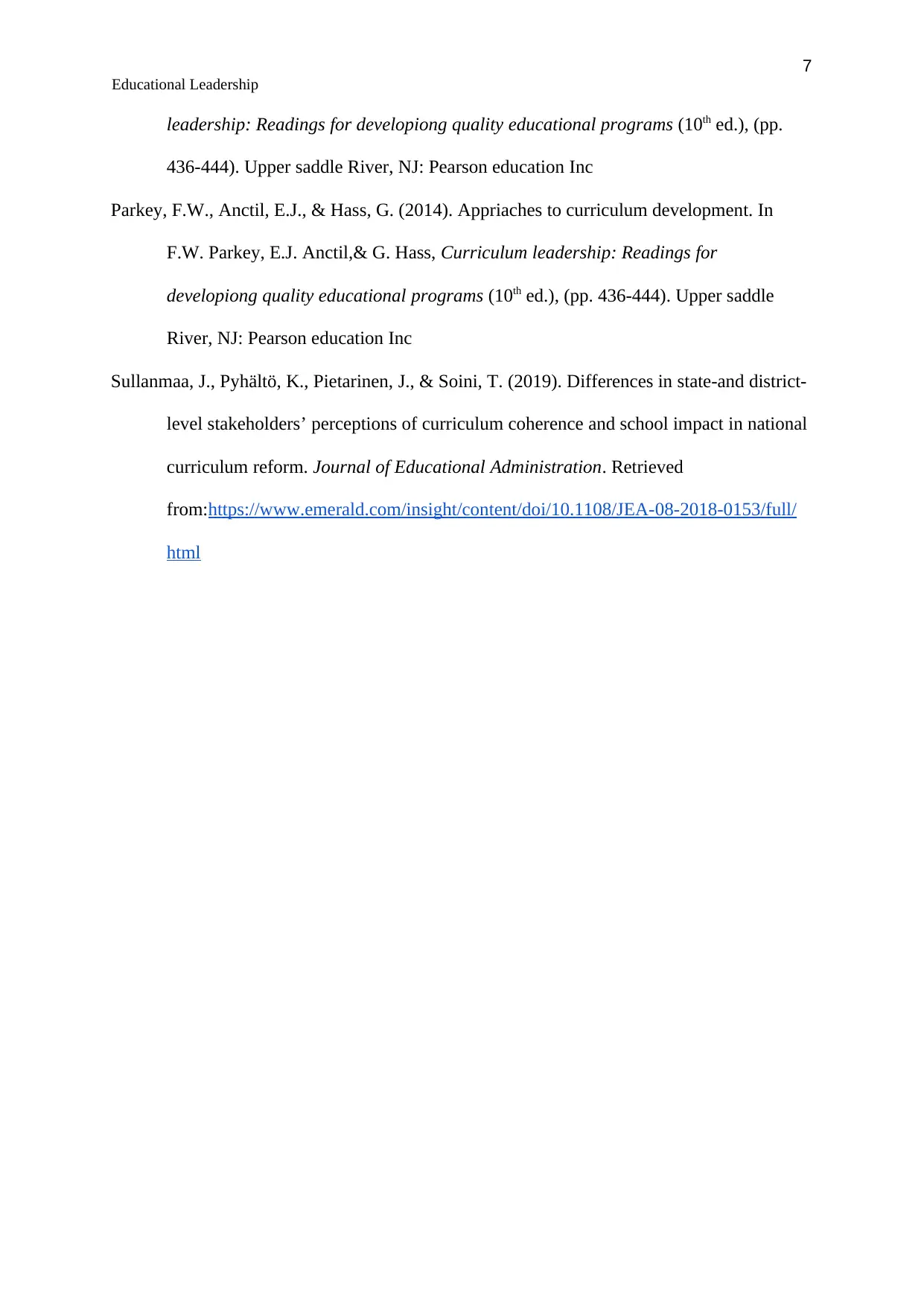
7
Educational Leadership
leadership: Readings for developiong quality educational programs (10th ed.), (pp.
436-444). Upper saddle River, NJ: Pearson education Inc
Parkey, F.W., Anctil, E.J., & Hass, G. (2014). Appriaches to curriculum development. In
F.W. Parkey, E.J. Anctil,& G. Hass, Curriculum leadership: Readings for
developiong quality educational programs (10th ed.), (pp. 436-444). Upper saddle
River, NJ: Pearson education Inc
Sullanmaa, J., Pyhältö, K., Pietarinen, J., & Soini, T. (2019). Differences in state-and district-
level stakeholders’ perceptions of curriculum coherence and school impact in national
curriculum reform. Journal of Educational Administration. Retrieved
from:https://www.emerald.com/insight/content/doi/10.1108/JEA-08-2018-0153/full/
html
Educational Leadership
leadership: Readings for developiong quality educational programs (10th ed.), (pp.
436-444). Upper saddle River, NJ: Pearson education Inc
Parkey, F.W., Anctil, E.J., & Hass, G. (2014). Appriaches to curriculum development. In
F.W. Parkey, E.J. Anctil,& G. Hass, Curriculum leadership: Readings for
developiong quality educational programs (10th ed.), (pp. 436-444). Upper saddle
River, NJ: Pearson education Inc
Sullanmaa, J., Pyhältö, K., Pietarinen, J., & Soini, T. (2019). Differences in state-and district-
level stakeholders’ perceptions of curriculum coherence and school impact in national
curriculum reform. Journal of Educational Administration. Retrieved
from:https://www.emerald.com/insight/content/doi/10.1108/JEA-08-2018-0153/full/
html
1 out of 7
Related Documents
Your All-in-One AI-Powered Toolkit for Academic Success.
+13062052269
info@desklib.com
Available 24*7 on WhatsApp / Email
![[object Object]](/_next/static/media/star-bottom.7253800d.svg)
Unlock your academic potential
Copyright © 2020–2025 A2Z Services. All Rights Reserved. Developed and managed by ZUCOL.





